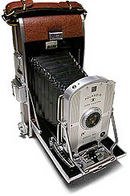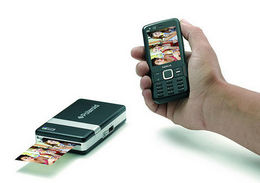Polaroid Camera
Dr. Edwin Land (a physicist) came to the forefront of photographic technology in 1929 when he created the first synthetic sheet polarizer; thus solving "one of science’s long-standing 'unsolvable' problems – polarizing light without needing a large crystal of an esoteric mineral" (Save Polaroid). Then, in 1937 Dr. Land founded the Polaroid Corporation. However, the idea of an instant camera (and subsequently instant photography) wasn’t envisioned by Dr. Land until 1943 in response to his 3-year-old daughter’s confusion as to why a camera could not instantly produce pictures – “Why can’t I see them now?” (New York Times).
Dr. Land was responsible for overseeing the development of products for the Polaroid Corporation – including the first instant camera. In 1947 the concept of instant photography was presented to The Optical Society in New York City and shortly after, in 1948, Polaroid 95 Instant photography became available to the public with the Polaroid Model 95 camera (also referred to as the Polaroid Land Camera) and Type 40 film. The Polaroid Land Camera was welcomed and widely accepted by consumer markets – even with a $95 price-tag (approximately $850 today) the cameras flew off shelves and sold out in a matter of weeks. The demand for the new camera was so great that backorders began being taken and consumers started to pay up to $150 (approximately $1350 today) for the new instant photography device (Save Polaroid).
A long line of instant photography developments and products proceeded the Polaroid Land Camera’s release and by the 1960’s approximately fifty-percent of American households owned a Polaroid camera (New York Times).
Contents
How it Works
Uses
Different Models
Public Reception
Controversy and Lawsuit
Fall
"There was a time when there was nothing to beat a Polaroid camera for instant gratification. But in a world of disposable cameras, one-hour film processing and the camcorder, Polaroid's...sales [suffered]" (ProQuest).
Although Polaroid began to see a drop in sales during the late-1990's some argued that it wasn't due to new progressive technology but rather due to poor marketing. Some claimed that the company was simply marketing it in the same category as "documentary" or "recording" devices when it should have been marketed as an "social enhancement device." For example, Martin Smith, BBH's deputy chairman, is cited as saying that "Polaroid operate[d] in a different market from 35mm cameras and advanced photography systems. Rather than recording the event, it add[ed] to it, and help[ed] it to become more informal. It [was] less about memories [and] more like alcohol and karaoke."
However, even with a marketing move away from traditional camera outlets and toward buying a Polaroid Camera to enhance social occasions (such as making the camera available at bars and clubs) sales continues to decline.
Death
It’s ironic that the death of the Polaroid (“Instant”) Camera resulted from the device’s inability to be “instant” enough. “But in a day when nearly every cellphone has a digital camera in it, ‘instant’ photography long ago stopped being instant enough for most people” (New York Times).
The Polaroid Company, which ceased their production of instant cameras for consumers a in 2007 and for commercial use in 2006, announced this year (2008) that it will also cease to produce and manufacture instant film come 2009.
However, the Polaroid Company is allowing their technology to be licensed to other manufacturers after 2009 – should they want to provide the film to the niche market that will continue to use the Polaroid Camera (New York Times). Furthermore, there has been confirmation that at least three of the peel-apart pack films will be reintroduced in 2009 (Zink).
Future
When the first Polaroid Camera was introduced in 1948 millions of individuals were, all of a sudden, able to quickly snap photographs and enjoy them instantly – instead of waiting several days, or longer, for them to be developed.
Today, Polaroid is once again leading the way for improvements in the “instantaneity” of photography – this time with photos taken by digital cameras and camera phones.
During the third quarter of 2008 the Polaroid Corporation partnered with Zink to create and market the Polaroid PoGo Instant Mobile Printer – a small, portable, battery-powered printer from the company that was built on Edwin Land's Polaroid (New York Times).
“Polaroid PoGo™ - short for Polaroid-on-the-go - is a pocket-sized, ink-free digital photo printer that produces full-color photos wirelesly from Bluetooth-enabled cell phones and via PictBridge from digital cameras. Weighing only eight ounces, Polaroid PoGo™ provides consumers with a convenient solution for sharing digital images trapped on cell phones and digital cameras. Connecting via Bluetooth or PictBridge, Polaroid PoGo™ uses a revolutionary ZINK Zero Ink Zero Hassles™ Printing Technology to produce borderless, full-color, 2-inch by 3-inch prints in less than 60 seconds” (Zink).
The Polaroid PoGo printer connects to cell phones wirelessly via Bluetooth technology and to digital cameras via a cable. The Printer, when first released, cost $150 but as of October 2008 can be purchased (from some sellers) for just under $100. The images produced by the PoGo are 2 inches by 3 inches.
The PoGo is unique in that it doesn’t use cartridges or toner (because it doesn’t use ink). “Instead, there is a computer chip, a 2-inch-long thermal printhead and a novel kind of paper embedded with microscopic layers of dye crystals that can create a multitude of colors when heated” (New York Times).
“When the image file is beamed from the camera to the printer, a program translates pixel information into heat information. Then, as the paper passes under the printhead, the heat activates the colors within the paper and forms crisp images” (New York Times).
The unique paper was created by former Polaroid employees and conceptualized at Polaroid. However, after Polaroid filed bankruptcy in 2001 (and was later sold to the Petters Group) the employees founded the company Zink Imaging in 2005 where the product was able to be developed and made available to buyers (New York Times).


